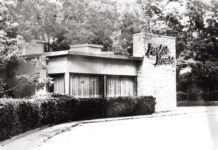
For 53 years, Archibald Gracie IV had never known suffering or hardship. He was born into the distinguished and very wealthy Gracie family of New York. His great-grandfather, Archibald Gracie, began amassing the family fortune as a shipping magnate and merchant in 1784 after arriving in America. The home he built, the opulent “Gracie Mansion,” has, to this day, served as the official residence of the mayor of New York City.
Young Archibald, the fourth in the aristocratic line, did not make his appearance until 1859 when he was born in Mobile, Alabama, where his father had moved to expand the family business with a lucrative cotton brokerage. Coming from a pedigree such as this, it’s hard to imagine Archibald IV experiencing the dangers and difficulties as a brave rescuer of so many passengers during the disastrous sinking of the Titanic.
Except for the fateful night of April 14, 1912, young Archibald’s life had, for the most part, been unremarkable. He had spent most of it managing his real estate investments, and as a shade-tree military historian. Although he did not graduate, he was educated at West Point, and was often referred to as “Colonel Gracie,” the rank he achieved while serving in the army.
Following that service, he continued to show a great interest and affection for the military. His father, Archibald III, was a West Point graduate, who was engaged in shipping cotton from Mobile when the Civil War began. Despite the objections of his New York family, Archibald’s father served as a brigadier general in the Confederate Army. Even before Alabama’s secession, he led his troops in seizing the Federal arsenal at Mount Vernon. But he is best known for his role in the pyrrhic Confederate victory at Chickamauga. There, his brigade, after making charge after charge, finally broke through the Union lines on a bloody knoll called Snodgrass Hill.
Although Archibald was only 5 years old when his father was killed at Petersburg, Virginia, in the closing days of the war, he maintained a life-long devotion for him. Infatuated with his role in the war, he spent seven years writing a book entitled “The Truth about Chickamauga.” The book was finished in 1912, and Gracie decided to take a break from the years of literary labor with a trip to Europe. He chose to make the trip alone, leaving behind his wife, Constance, and daughter, Edith. As he was accustomed, Gracie booked first-class passage from New York aboard the Oceanic, and arranged to make the return trip from Southampton, England on the luxurious Titanic, which was
often described as “practically unsinkable.”
On April 10, 1912, Gracie boarded the Titanic for the transatlantic trip home. Soon after starting the voyage, he recognized three of the passengers as sisters he knew from the past. The ladies were returning to the United States after attending a family funeral in England. Although this was the period of unfettered wealth in the Gilded Age, Gracie sustained the strict moral code of the genteel Elizabethan Era. Hence, when he became aware the sisters, along with their friend, Miss Edith Evans, were travelling alone without escort, he offered them the service of his protection.
As the days of the voyage passed, Gracie spent his time in social enjoyment, reading books from the ship’s library, exercising in the gymnasium and playing squash with Frederick Wright, a professional racquet coach. Gracie was a man of unusual strength with a powerful physique, and his primary concern during the trip was maintaining a rigorous exercise routine. Aside from that, he spent time with friends, Clinch Smith and Edward Kent. The three of them had dinner together on Sunday night, April 14, then adjourned to the Palm Room for coffee where they listened to the ship’s band. Gracie, intending to rise early the next morning for his exercise session, retired to his cabin before 9 p.m.
After only a few hours of sleep, he was awakened by a shocking jolt, and noted the time was 11:45 p.m. Concerned something was wrong, Gracie dressed and made his way to the boat deck. The night air was cold and moonless, with the only light coming from the stars. Wandering the deck, all was quiet without any reason for concern. But then he came upon a group of passengers huddled together, who informed him the ship had collided with an iceberg. The vessel, they were told, was taking on water and those around him were putting on life preservers. This sent Gracie back to his stateroom where he packed his bags, anticipating that everyone would be transferred aboard another ship.
Before midnight, when the order was given to load the lifeboats, Gracie located the ladies he had promised to protect, and led them up to the deck. Only women and children were allowed in the limited number of lifeboats, and men were not allowed to approach as the crew assisted with the loading. Thus, Gracie left the ladies in the custody of one of the ship’s officers, and he and his friend, Clinch Smith, began helping one of the ship’s steward distribute blankets among the 15 lifeboats. Throughout the chaos, most men behaved as gentlemen. Only one incident occurred when a group of men tried to board one of the lifeboats, but were forced out at gunpoint by a ship’s officer.

As the hours slipped away, Gracie and his friend, Smith, were assisting one of the ship’s officers, helping women and children into the last lifeboat which was lowered at 1:45 a.m. One of the ladies Gracie lifted into the boat was Ava Astor, daughter of John Jacob Astor, thought to be the wealthiest man in America at that time. Astor, however, did not survive the night.
Before the last boat left, Gracie noticed Isador and Ida Straus, an elderly couple who were co-owners of Macy’s, the famed New York department store. They were returning from a vacation on the French Riviera. Gracie tried to persuade Mrs. Straus to board the last lifeboat, but she refused, saying to her husband; “We have lived together many years. Where you go I go.” Gracie last saw the couple sitting in deck chairs, arm in arm.
At 2 a.m., the last of the distress rockets were fired into the night air, and all the lifeboats had departed. There were, however, four collapsible canvas boats left, and all the women who could be found were put on these. With some room left, a few men were allowed aboard these boats. There were, unfortunately, female passengers who did not survive. One of them was Edith Evans, whom Gracie had offered his protection. She had become separated from the sisters and died in the sinking.
Fifteen minutes later, the bridge of the Titanic plunged into the sea, and a crowd of passengers rushed towards the stern. Gracie and Clinch Smith were among them, but could not reach the stern before a wave of water rushed over them sweeping Smith from the deck, never to be seen again. Gracie managed to hang on, gripping the bottom rung of a ladder as the ship began disappearing into the ocean. Soon the undertow from the sinking pulled him into the freezing water. “I was forced to let go,” remembered Gracie, “and I was swirled around and around for what seemed an interminable time. Eventually, I came to the surface to find a sea amass of tangled wreckage.”
Numbed in the frigid water and trying to recover his breath, Gracie saw one of the canvas rafts floating nearby with a man clinging to some wreckage and trying to get into it. Swimming there, he helped him get on the raft then lifted himself aboard. Gracie never learned the man’s name, but the two of them began rescuing other survivors thrashing in the sea. “When dawn broke,” Gracie recalled, “there were 30 of us on the raft, standing knee deep in the icy water and afraid to move lest the shaky craft be overturned.” Unfortunately, they were unable to save others without causing the raft to capsize, and Gracie deeply regretted that.
At dawn, the men on the sinking raft spotted the steamer Carpathia, miles in the distance picking up survivors as it approached. By this time, the men were near the breaking point with some of them becoming hysterical. “The hours that elapsed before we were picked up by the Carpathia were the longest and most terrible that I ever spent,” remembered Gracie.
It was 8:30 that morning before he was finally rescued from the raft while still working to try and save a lifeless body lying next to him. Once aboard the Carpathia, Gracie, who first believed he was unhurt, discovered his injuries; cuts and bruises all over his body and a wound to his head. Later, he would suffer from the prolonged effects of hypothermia. Yet, considering over 1,500 people perished in the disaster, he was fortunate enough to be among the near 700 who survived. In fact, Archibald Gracie was believed to be the last survivor to leave the Titanic.
Eight months after the disaster of the Titanic, Gracie was facing health problems resulting from the effects of hypothermia and complications from diabetes. On December 4, 1912, he died at his ancestral home in New York City, surrounded by family members. Apparently, he never recovered from the trauma of that night when the Titanic sank. Haunted by those memories, the family remembered his last words: “We must get them into the boats. We must get them all into the boats.”





